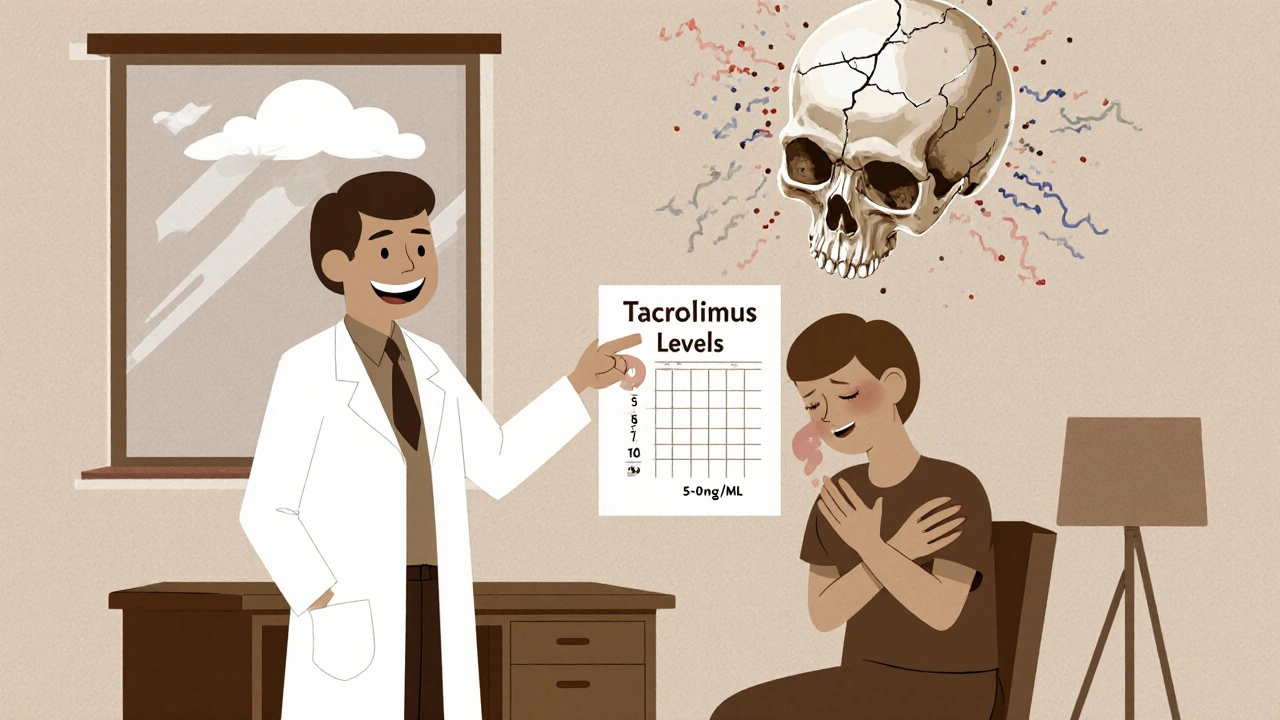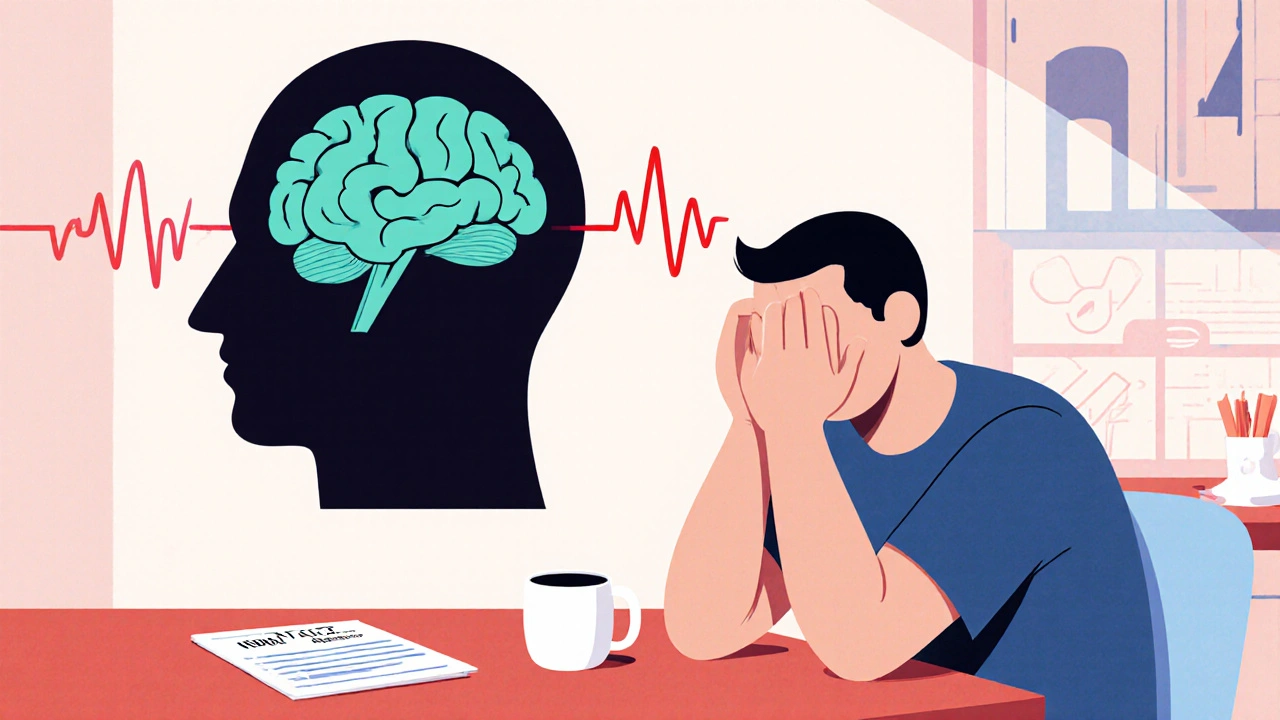Tacrolimus Neurotoxicity Risk Assessment
This tool is designed to help you understand your individual risk for tacrolimus neurotoxicity based on factors discussed in the article. It is for educational purposes only and should not replace professional medical advice. Please discuss your symptoms with your transplant team.
Your Transplant Type
Age Category
Medications
Electrolyte Status
Genetic Factor
Your Risk Assessment
Tremor, Headache, and the Hidden Risk of Tacrolimus
If you’ve had a kidney, liver, heart, or lung transplant, you’ve likely been prescribed tacrolimus. It’s one of the most powerful drugs out there at keeping your new organ from being rejected. But for 1 in 3 transplant patients, it comes with a hidden cost: neurological side effects. Tremors that make holding a coffee cup impossible. Headaches so intense they feel like a vise around your skull. These aren’t rare quirks-they’re common, underreported, and often misunderstood.
Even when your blood levels are "in range," you can still get sick from it. That’s the cruel twist. Doctors check your tacrolimus levels, see they’re between 5 and 10 ng/mL, and say you’re fine. But if you’re shaking, dizzy, or can’t sleep, you’re not fine. And too often, it takes weeks for your care team to connect the dots.
What Tacrolimus Neurotoxicity Actually Looks Like
Tacrolimus doesn’t just cause one symptom-it triggers a whole chain of neurological reactions. The most common? Tremor. About 7 out of 10 patients who experience neurotoxicity report uncontrollable shaking, usually in the hands. It starts subtly-maybe you drop your spoon or can’t sign your name clearly. Then it gets worse.
Headache is the second most frequent complaint. Not just any headache. These are deep, pounding, persistent headaches that don’t respond to ibuprofen or rest. Patients on transplant forums describe them as "crushing," "like a band tightening around the brain," or "worse than migraines I’ve ever had." One patient on Reddit wrote: "I was on 6.8 ng/mL-perfect level-and still couldn’t function. The headaches only stopped when they switched me to cyclosporine."
Other symptoms pile on: tingling in fingers and toes, trouble sleeping, dizziness, weakness, confusion, even trouble speaking. In rare but serious cases, patients develop posterior reversible encephalopathy syndrome (PRES)-a condition where the brain swells, causing seizures or vision loss. It’s rare, but it’s real. And it needs immediate action.
What’s scary is how often these symptoms are dismissed. A 2022 survey found that 55% of patients waited 2 to 3 weeks before their doctors even considered tacrolimus as the cause. By then, the tremor might be constant, the headache unrelenting, and the fear of rejection has kept them from asking for help.
Blood Levels: The Myth of the "Safe Range"
Most transplant centers aim for tacrolimus levels between 5 and 15 ng/mL, depending on the organ. Kidney patients? Usually 5-10 ng/mL. Liver? Same. Heart? Also 5-10. These numbers come from decades of studies showing these levels prevent rejection.
But here’s the problem: neurotoxicity doesn’t care about the range. A 2023 study in Annals of Transplantation found that patients with severe tremors and headaches had average tacrolimus levels that were statistically identical to patients who felt fine. Some people get neurotoxic symptoms at 6 ng/mL. Others tolerate 18 ng/mL without a single tremor.
Why? Because blood levels don’t tell you what’s happening in your brain. Tacrolimus crosses the blood-brain barrier, but not everyone’s barrier is the same. Some people’s brains soak it up like a sponge. Others barely let it in. That’s why a level that’s safe for one person can be toxic for another.
And it’s not just about the dose. Certain medications can make it worse. Antibiotics like linezolid, sedatives like midazolam, even antipsychotics like risperidone can pile on top of tacrolimus and push you into neurotoxic territory-even if your level looks normal.

Who’s Most at Risk?
Not everyone gets neurotoxicity. But some groups are far more likely to.
Liver transplant patients have the highest risk-nearly 36% experience symptoms. Kidney recipients? Around 22%. Heart and lung patients? Lower, at 15-19%. Why? No one’s completely sure. But liver transplants often involve bigger doses, longer hospital stays, and more complications that may make the brain more vulnerable.
Age matters too. Older patients are more likely to develop tremors and confusion. But even young, healthy people aren’t safe. Genetics play a huge role. About 25% of people have a gene variant called CYP3A5*1 that makes them process tacrolimus much faster. Their bodies burn it off quickly, so they need higher doses to stay protected from rejection. But those higher doses? They’re more likely to cause neurotoxicity.
And then there’s electrolytes. Low sodium (hyponatremia) is a silent trigger. One study found that correcting sodium levels alone reversed mild neurotoxicity in nearly 30% of cases-without touching the tacrolimus dose.
What to Do When Symptoms Start
If you notice shaking, persistent headaches, confusion, or trouble walking, don’t wait. Don’t assume it’s stress or fatigue. Tell your transplant team immediately.
The good news? Most cases get better quickly once you act.
Here’s what usually works:
- Lower the dose. Reducing tacrolimus by 10-20% often stops symptoms within days. One patient on the National Kidney Foundation forum saw tremors vanish in 72 hours after dropping from 0.1 mg/kg to 0.07 mg/kg.
- Switch to cyclosporine. It’s less effective at preventing rejection, but it’s also less neurotoxic. About 42% of patients with severe symptoms are switched, and most feel better within a week.
- Check your electrolytes. Get a simple blood test for sodium, magnesium, and calcium. Low levels can mimic or worsen neurotoxicity. Fixing them might be all you need.
- Review other meds. Make sure you’re not on anything that interacts with tacrolimus. Ask your pharmacist to do a full drug interaction check.
Don’t stop tacrolimus on your own. Rejection can kill faster than neurotoxicity. But with careful adjustment, you can protect your brain without losing your transplant.
The Future: Personalized Dosing and New Drugs
Right now, we’re still flying blind for many patients. We check blood levels, but we don’t check brain exposure. That’s changing.
A 2021 study from the University of Toronto showed that testing for the CYP3A5 gene before starting tacrolimus could reduce neurotoxicity by 27%. If you’re a fast metabolizer, you get a higher starting dose. If you’re slow, you get less. Simple. Effective. But only a few academic centers offer this test-and insurance rarely covers it.
There’s also a new drug in the pipeline called LTV-1. It’s designed to work like tacrolimus but can’t cross into the brain as easily. Early trials show it’s just as good at preventing rejection-and way less likely to cause tremors or headaches. If it gets FDA approval by 2027, it could replace tacrolimus as the gold standard.
Until then, the best tool you have is awareness. Know your symptoms. Track them. Speak up. Your transplant team needs to hear from you.

Real Stories, Real Impact
"My tremor started three weeks after my transplant," says a patient named Sarah on a transplant forum. "I thought it was nerves. I didn’t say anything because I was so grateful to be alive. Then I couldn’t button my shirt. That’s when I asked. They lowered my dose. Within 48 hours, I could write again. I didn’t know it could be fixed so fast."
Another patient, Mike, had constant headaches for six weeks. His levels were "perfect." His neurologist said, "It’s probably stress." He went to a second doctor, who asked, "Are you on tacrolimus?" They cut his dose. The headache was gone in three days.
These aren’t outliers. They’re the norm. And they’re preventable.
What You Can Do Today
Don’t wait for a crisis. Take action now:
- Keep a daily log: Note any tremors, headaches, dizziness, or sleep issues.
- Ask your pharmacist: "Do any of my other meds interact with tacrolimus?"
- Request a CYP3A5 genetic test if you haven’t had one.
- Get your sodium and magnesium levels checked every month for the first 90 days.
- Don’t be afraid to say: "I think this might be the tacrolimus. Can we look at my dose?"
Transplant is a second chance. But it shouldn’t cost you your quality of life. You deserve to feel well-not just alive.
Can tacrolimus cause tremors even if my blood level is in range?
Yes. Many patients develop tremors, headaches, or confusion even when their tacrolimus blood levels are within the recommended therapeutic range (usually 5-10 ng/mL). Neurotoxicity depends on individual brain exposure, which varies due to genetics, blood-brain barrier differences, and interactions with other medications-not just the amount in the bloodstream.
Which transplant patients are most at risk for tacrolimus neurotoxicity?
Liver transplant recipients have the highest risk, with about 36% experiencing neurotoxic symptoms. Kidney transplant patients follow at around 22%, while heart and lung recipients have lower rates (15-19%). Older age, low sodium levels, and having the CYP3A5*1 gene variant also increase risk.
How long does it take for neurotoxic symptoms to go away after lowering the dose?
Most patients see improvement within 3 to 7 days after reducing the tacrolimus dose or switching to an alternative immunosuppressant like cyclosporine. In some cases, tremors and headaches resolve in as little as 48 hours, especially if electrolyte imbalances are corrected at the same time.
Can other medications make tacrolimus neurotoxicity worse?
Yes. Drugs like linezolid, midazolam, propofol, haloperidol, lorazepam, risperidone, and olanzapine can increase the risk of seizures and worsen neurological symptoms when taken with tacrolimus. Always review all medications-prescription, over-the-counter, and supplements-with your pharmacist or transplant team.
Is there a genetic test that can help prevent tacrolimus neurotoxicity?
Yes. Testing for the CYP3A5 gene can identify whether you’re a fast or slow metabolizer of tacrolimus. Fast metabolizers need higher doses to prevent rejection but are at greater risk for neurotoxicity. Studies show that using this test to guide dosing can reduce neurotoxicity by up to 27%. While not yet standard everywhere, it’s becoming more available in major transplant centers.
What Comes Next?
Neurotoxicity isn’t going away. But awareness is growing. More transplant centers are starting to monitor patients closely in the first 30 days after surgery-the peak risk window. And more patients are speaking up, demanding better care.
If you’re on tacrolimus, you’re not alone. And you don’t have to suffer in silence. Your symptoms matter. Your voice matters. Speak up. Track your changes. Ask for help. You’ve fought hard to get your transplant. Now fight for your brain, too.


Write a comment